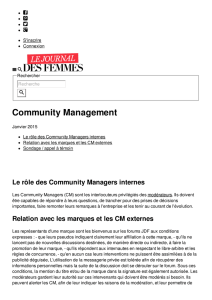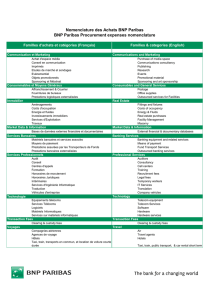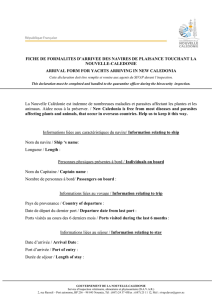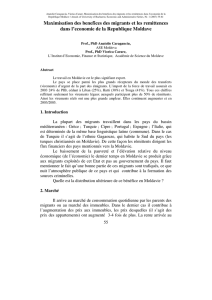Développement des communautés virtuelles - E
publicité
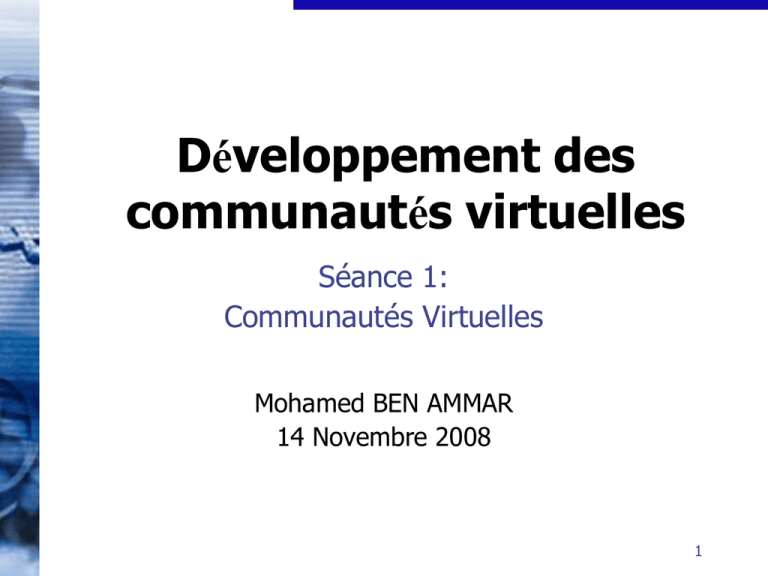
Développement des communautés virtuelles Séance 1: Communautés Virtuelles Mohamed BEN AMMAR 14 Novembre 2008 1 Communautés virtuelles Définition et critères de succès 2 Définition What is community? A set of interwoven relationships built upon shared interests, which satisfies members’ needs otherwise unattainable individually 3 Intérêts communs Au niveau de l’information (Information produit) Au niveau d’une activité Ebay (achat et vente) Au niveau d’une caractéristique commune 4 5 6 Quelques caractéristiques importantes Publique vs privée Politique de membership Commerciale vs non-commerciale Communication en temps réel ou non (asynchrone) Outils de communication Clavardage, newsgroup (email), bulletin boards, etc. 7 Critères de succès People Criteria Process Criteria Membership is a conscious choice Members achieve benefits of scale Member base has achieved critical mass and sustainability Roles are not hierarchical or imposed Members feel a great sense of trust Effective facilitation and site structure keeps activities on track Culture Criteria A spirit of participation and feedback is clearly cultivated A sense of affiliation is achieved through ownership of equity in the community Technology Criteria Efficiency in interaction is maximized The community is easily navigable 8 Communautés Création et transfert de valeur à l’intérieur de la communauté 9 Transfer of Value Triangle Administrator to User: User to Administrator: Examples of Types of Value Created and Shared Administrator-generated content / proprietary content (e.g., articles, editorials) Mailing lists Newsletters Webcasts (e.g., of guest speakers) Supervised chats (e.g., chats featuring guest Q&A) Offline events (e.g., parties for members within geographic proximity) Rewards points (e.g., to use on goods or services traded within the community) Examples of Types of Value Created and Shared Community subscription fees Content fees Fees to engage in an activity (e.g., online video-game participation) Commission fees (e.g., for goods sold through the community) Increased value for selling online advertising space Transfer of Value in Communities User to User: Examples of Types of Value Created and Shared User-generated content (e.g., information, opinions, advice) Distribution of digitizeable goods (e.g., MP3s, shareware) Transactions for goods Relationships / support / conversation 10 Communautés Création et transferts de valeur à l’extérieur de la communauté 11 Bénéfices d’une communauté pour une compagnie Relation client Outil relationnel Branding Utiliser la communauté pour relayer les valeurs de la compagnie Segmentation Profils des usagers Marketing Publicité sur communauté virtuelle Attirer de nouveaux clients Marketing viral (WOM) Recherche marketing Ex.: Test de concept Service à la clientèle Ex.: FAQ, Discussion board, etc. 12 13 MSN Gaming Zone Publicité d’un nouveau jeu sur la page d’accueil de la communauté 14 15 Communautés Cycle de vie des membres d’une communauté virtuelle 16 Références Mohammed, R.A., Fischer, R.J., Jaworski, B.J. et Paddison, G.J. (2004), Internet marketing: building advantage in the networked economy, 2ième édition, McGraw Hill. Johnson, G.J. et Ambrose, P.J. (2006), “NEO-TRIBES: THE POWER AND POTENTIAL OF ONLINE COMMUNITIES IN HEALTH CARE,” Communications of the ACM, 49 (1), 107-113. Nardi, B. A., Schiano, D. J., Gumbrecht, M., Swartz, L. (2004), “WHY WE Blog,” Communications of the ACM, 47 (12), 41-46. Nunes, P. (2005), “The Risks of Customer Intimacy” MIT Sloan Management Review, 47 (1), 15. 18









